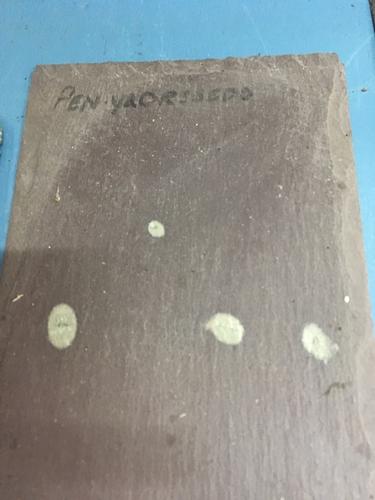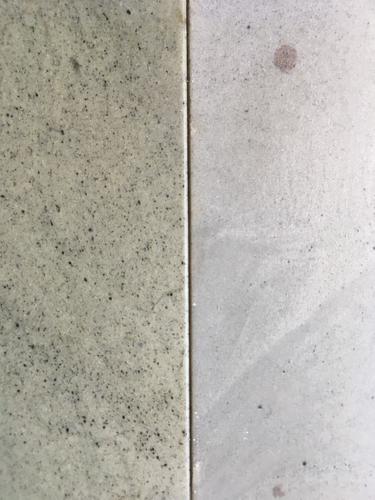Results 1 to 10 of 12
-
10-07-2018, 02:58 PM #1Senior Member

- Join Date
- Oct 2015
- Location
- Switzerland
- Posts
- 104
Thanked: 52 the "real" melynllyn/yellow lake hone?
the "real" melynllyn/yellow lake hone?
as far as i know there are two types of melynllyn or yellow lake hones: the black ones, often sold with a salmen label, and the purple type, sometimes with green dots. i have stones of both types:

well, so i came back from a one week hiking trip in wales this afternoon. we walked to the melynllyn (yellow lake) and i collected a few stones from the disused melynllyn hone quarry (labelled like that on the OS map). some still have saw marks on the sides. the strange thing is that these stones look completely different from my other yellow lake hones: light green (greener than on my pictures) with small black spots, quite flaky. i lapped three pieces and honed a razor that will be used tomorrow morning. the stones are rather hard, and it is very difficult to raise a slurry:


with purple and black yellow lake hones:

i was surprised to see that the purple slate with the green dots is extremely common in wales. it is mainly used as a paving stone:


at inigo jones i was told that this slate comes from the penrhyn quarry near bethesda. however in their exhibition i noticed a sample that was marked with pen yr orsedd, an now closed quarry in the northwest of wales in the nantlle valley:

last picture shows one of my new melynllyn hones (right) next to a llyn idwal (melynllyn dry, idwal with oil):

quite confusing, all this, isn't it?
regards,
hansLast edited by brightred; 10-07-2018 at 03:04 PM.
-
The Following 4 Users Say Thank You to brightred For This Useful Post:
DoughBoy68 (10-07-2018), earcutter (10-07-2018), Geezer (10-07-2018), ScoutHikerDad (10-08-2018)
-
10-07-2018, 03:12 PM #2Senior Member




- Join Date
- Feb 2013
- Location
- Haida Gwaii, British Columbia, Canada
- Posts
- 14,450
Thanked: 4829
I have done quite a bit of rockhounding for the purposes of making hones, but not in that area. To get a piece good for hones it needs to be stable, no bad inclusions, very even grit and soft enough to shape. If you start looking at the structure of a rock formation you will see it change and a lot of bands within the formation. You do not have to stray to far for the rock to change enough that it is not exactly the same. As you move from one band to the next you get changes in colour. You can get many different appearing hones from a single quarry.
It's not what you know, it's who you take fishing!
-
10-08-2018, 11:05 AM #3

We await your tests with interest.
I've got a purplish stone a bit like yours that I accepted as a LM from descriptions posted here by people regarded as authoritative. My opinion now is that these things are pretty variable and there have probably been a range of stones sold as LMs over the years. Mine is actually OK as a finisher: I'd rate it as equivalent to an 8 to 10k synthetic.
-
10-08-2018, 01:08 PM #4Senior Member



- Join Date
- Apr 2012
- Location
- Diamond Bar, CA
- Posts
- 6,553
Thanked: 3215
Go to any stone slab yard and look at the slabs sold for counter tops where the large slabs have been sliced into 1.25-inch, slabs and you can leaf through and see they are sequence cut from the same stone. You will notice how much the patterns can change from one side to the other, in just 1 inch. So, it is not uncommon for stone quarries to leave stones that determined were not as pure, as they were graded coming out of the mine.
Add to that, the razor market is and always has been a very small part of the much larger tool and knife sharpening market and it makes sense they would take the stones easiest to sell to transport down the mountain.
I have several purple stones, and some from Indigo some can finish. The purple Yellow Lake and the Vosgienne look similar both with the green spots. There are several old posts under Vosgienne, and the “Brown Escher”, (that was a heated controversy on this and other fora a few years ago), from the Vosges mountains between France and Germany.
The La Lune stones another marketing brand for the French stones, I have seen labeled, in both the purple a grey coloring. These were marketed as razor stone that some claim equivalent to a 15k grit. With all-natural stones such claims may be possible but only from stone to stone, and technique becomes a factor.
As with most naturals the advent of known grit, inexpensive synthetic stones made the labor-intensive quarrying of natural stones less profitable.
None of the stones I have are labeled, marked or boxed so their origin is unknown. For me all that matters is if they can finish.
I have had the best luck finishing the stone on a high grit diamond plate 1k and using a slurry stone to smooth and create slurry, from the same stone diluting the slurry much like a coticule and using Smith’s honing fluid and water as a lubricant. Smith’s washes off with soapy water and does not affect the stone.
-
10-08-2018, 02:03 PM #5Senior Member

- Join Date
- Oct 2015
- Location
- Switzerland
- Posts
- 104
Thanked: 52
@euclid, rezdog: this melynllyn quarry is really, really small. you don't find one type of stone in one corner of the quarry and another type in another corner two hundred meters away. we are talking about maybe 30 x 30 meters. it is hard to imagine that all the salmen yellow lake stones come from that quarry. i collected stones from the scree slope below the quarry and stones with saw marks a hundred meters down near a collapsed building. in the area i have not seen anything that resembles a dark grey or a purple slate. of course this does not mean that there is no such thing. i spent only about half an hour in and around the quarry.
@euclid: do you think that "yellow lake" was just a salmen brand, and these hones were not mined in the melynllyn quarry? is there any proof that there were hones labelled "melynllyn" instead of "yellow lake"? is it possible that somebody thought that yellow lake stones have to be from the melynllyn quarry, simply because "melyn llyn" means "yellow lake", without having any proof?
@maladroit: the hone is a decent finisher. i raised a thin slurry with a smaller piece of green melynllyn, which takes some time. the slurry is very bright, a little bit green. it turns black quickly. i finished on water only. 12 linen, 60 leather, passed hht with some difficulties. the shave was ok, not very close but smooth enough. i usually use natural japanese hones.
regards,
hans
-
10-08-2018, 10:44 PM #6

To be clear, purple slates or hones are quite common on different spots around the
World. Also the fact that the hone business often or most likely is connected to the
Roofing slate business. I never researched the Salmens story in detail Hans but Salmens surely was a Brand and iam not convinced that all the slate hones must have been quarried at that spot. So for sure there might be several spots or quarries where the stones might have their origin....
Puple Hones La Lunes and the FGBC Trademark....FGBC or La Lune was also a Trademark. Same here, different types of stones were sold during the time...also here other quaries have been picked.
If youre interested to start more research feel free to PM me....███▓▒░░.RAZORLOVESTONES.░░▒▓███
-
10-09-2018, 03:57 PM #7Senior Member



- Join Date
- Apr 2012
- Location
- Diamond Bar, CA
- Posts
- 6,553
Thanked: 3215
@euclid: do you think that "yellow lake" was just a salmen brand, and these hones were not mined in the melynllyn quarry? is there any proof that there were hones labelled "melynllyn" instead of "yellow lake"? is it possible that somebody thought that yellow lake stones have to be from the melynllyn quarry, simply because "melyn llyn" means "yellow lake", without having any proof?
Marketing is marketing, and one has only to look at the successful marketing of the vaulted Escher stone, Escher was an importer, distributor and those that know where the stones came from are long gone. Escher labeled stones were/are consistent performers, but Thüringan overall are consistent performers.
Some say, folks are currently collecting Jnat stones from closed mine tailings, stamping them with copies of vintage mines and sold as rediscovered vintage. Well, the stones are “vintage” but are they from the stamped mine? Who knows, for most all that matters is performance.
It is not uncommon for distributors to brand for different markets with various labels/ brands and to market stones from different mines under one label.
Here is an old post by Neil Miller, (here) who was a very knowledgeable member, with long and deep teniacls of knowledge. It was rare that Neil did not know about a razor related subject, and often very detailed, first-hand information.
In this post he says that Yellow Lake was simply a brand name, under the A.B.Salmen brand, stones were mined from different mines and there were at least 4 varieties of the Salmen stones.
Interestingly the advertisement states all the stones they imported, and list the sale of Hones, Grindstones and Building Materials. Also, of note is the variety of stones, Salmen imported, even “Arkansa” stones, clearly, they did not quarry them all.
-
10-09-2018, 05:46 PM #8Senior Member

- Join Date
- Oct 2015
- Location
- Switzerland
- Posts
- 104
Thanked: 52
thank you all very much for your help!
euclid, i browsed that thread but somehow missed neil miller's post. he seems to confirm what i suspected: that yellow lake is a brand and not necessarily the place where the hones were mined.
unfortunately, my photos are a bit crappy as the sun was right above/behind the quarry. but i found a website about mine exploration and there are a few pictures of the melynllyn quarry which are better than the ones i took. you can see how small the quarry was. i collected stones near the building and from the debris a bit below the lower level:
https://www.aditnow.co.uk/Album/Phot...elynllyn_1887/
best regards,
hans
-
The Following User Says Thank You to brightred For This Useful Post:
doorsch (10-11-2018)
-
10-09-2018, 09:31 PM #9

How deep did the holes go?
-
10-10-2018, 07:03 AM #10Senior Member

- Join Date
- Oct 2015
- Location
- Switzerland
- Posts
- 104
Thanked: 52
i walked up to the first level only. this hole is not deep at all, maybe 2 meters. you can see the end of the hole in a picture i took.

on aditnow.co.uk it says about the upper level: "Goes in a bit further than the lower level, but still not very far." (https://www.aditnow.co.uk/Photo/Upper-Level_77371/)
to get an impression of the landscape: i made the photo below maybe half a mile away from the quarry. you can hardly see the quarry, the collapsed building is barely visible. the quarry is in the shade on the hillside on the left hand side, above the high grass.

regards,
hans
-


 24Likes
24Likes LinkBack URL
LinkBack URL About LinkBacks
About LinkBacks






 Reply With Quote
Reply With Quote
